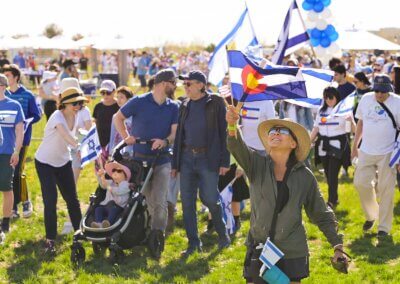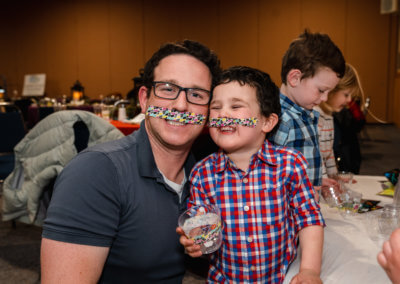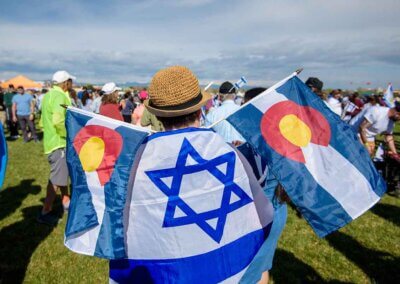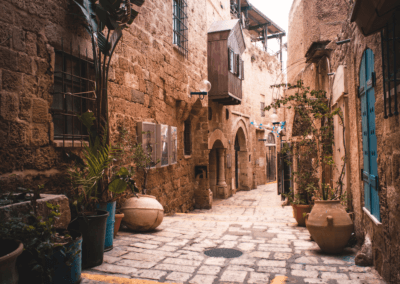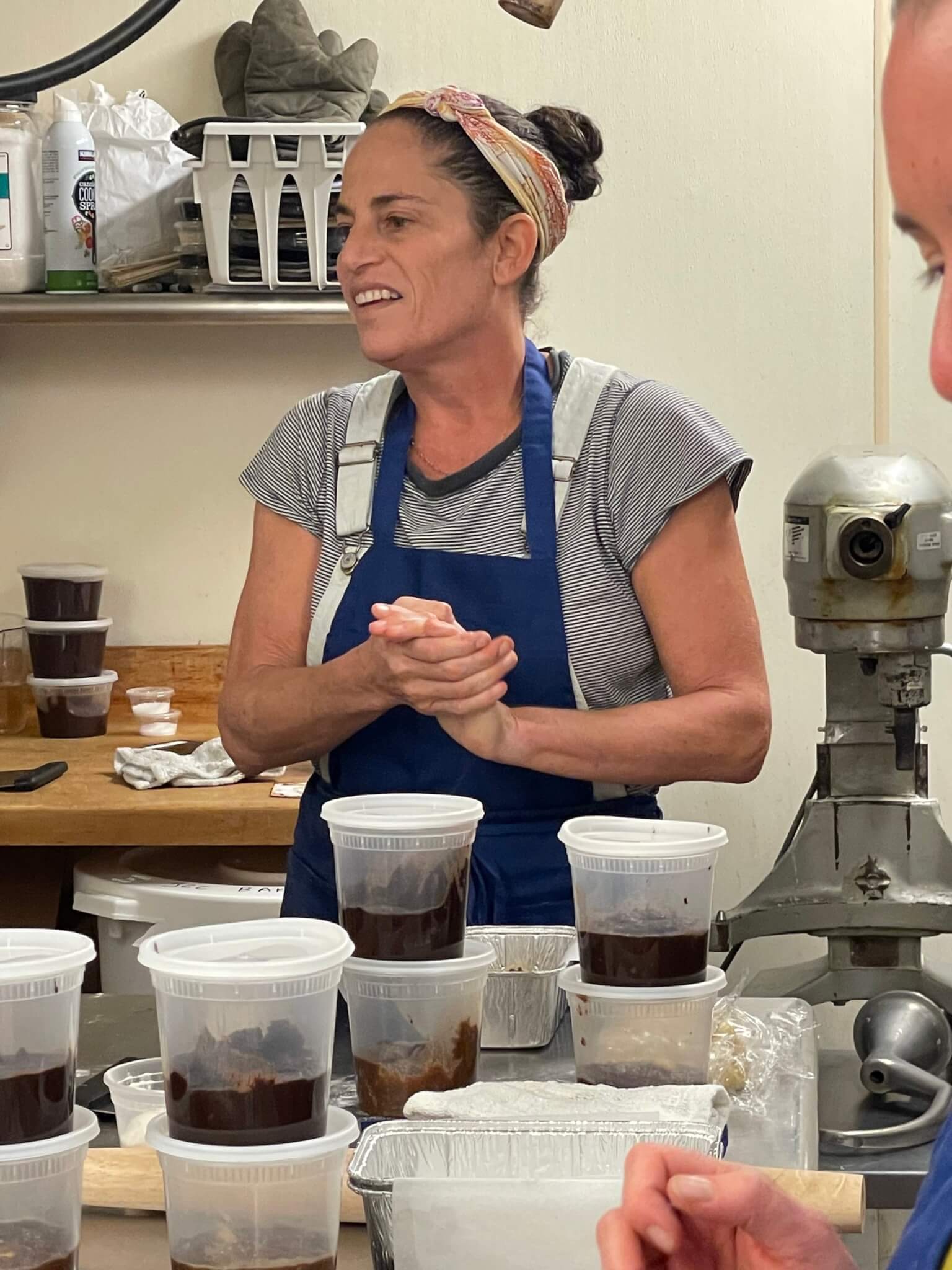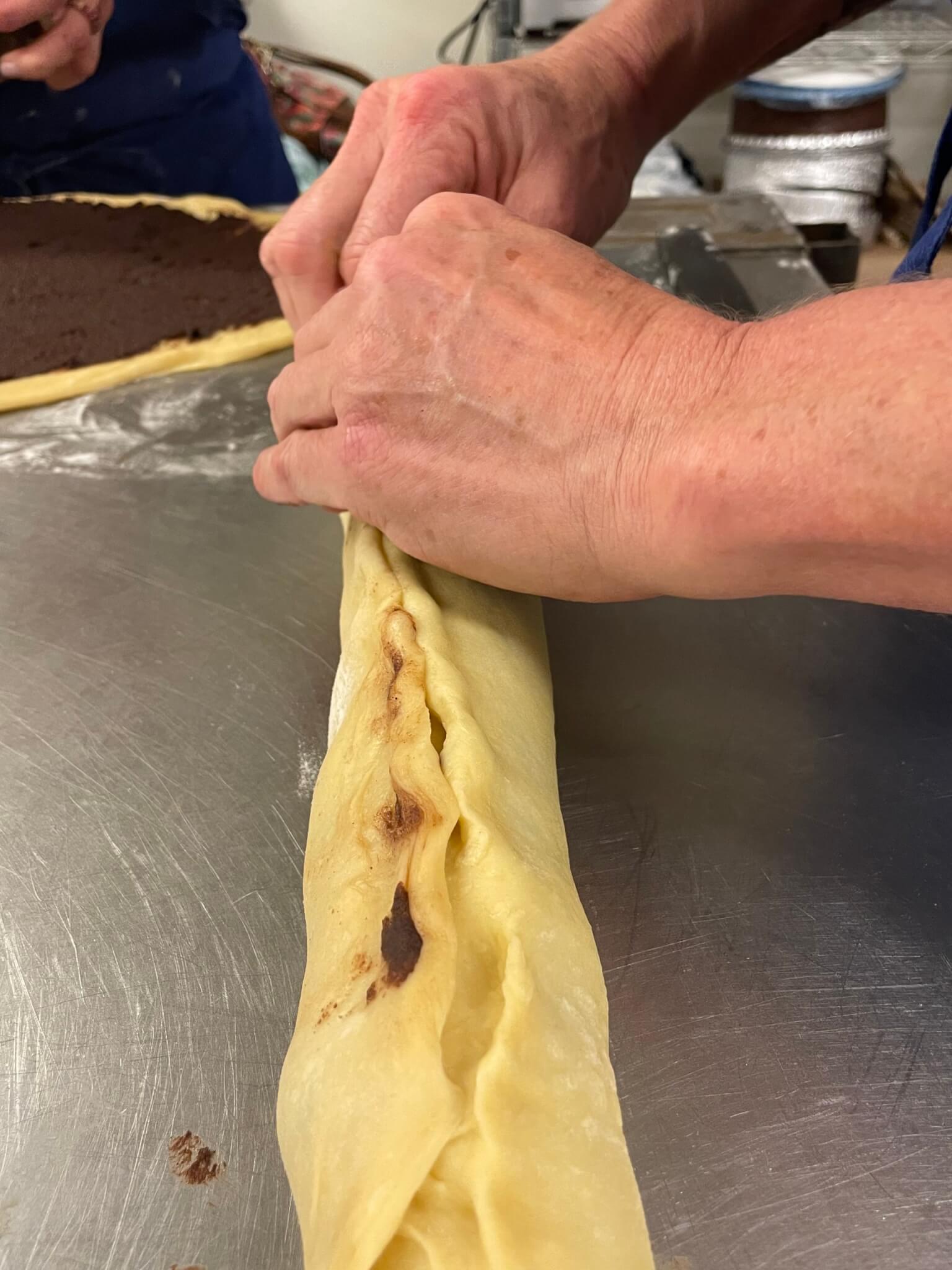Making Babka with Luisa Hagemeier
By: Bill St John
For JEWISHcolorado
It’s a bread that tastes like cake! It’s a cake that looks like bread!
It’s babka! That twisted, swirling, yeasty sweet dough that’s striated and marbled and so-deliciously veined with schmears of cinnamon or chocolate (or both, and more!), domed with a crumby streusel and soaked in sugar syrup—as if there weren’t sufficient sweet things there already.
It’s thought that the word “babka” derives from the Polish for grandmother (“baba” or, sometimes even, “babka”), similar to the Yiddish, “bubbe.”
Why “grandmother,” though? Associations of comfort food, perhaps, or that the swirls of a cut slice of babka resemble an old woman’s ruffled skirt. (Hardly appetizing eater’s etymology, to my way of thinking. Let’s opt for the baba/bubbe theory.)
Luisa Hagemeier, a Denver-based baker (@challahradohearth) who earned her baking chops at her native New York City’s Silver Moon Bakery, is a babka maven—and mother and bubbe/baba herself.
And she is a fine teacher, too, recently leading a small group of students through a babka-baking class at Denver’s Staenberg-Loup Jewish Community Center.
There is a lot more to baking babka than a mere twist and shout for joy.
The origin story of babka has Polish bakers utilizing leftover pieces of challah dough by interleaving them with savory or sweet fillings, then baking them off as flavored loaves. “But,” says Hagemeier, “the difference in the doughs between babka and challah is that challah uses oil and babka uses butter.
“You can use a cinnamon schmear to make a cinnamon challah,” she adds, “but it’s not a cinnamon babka.”
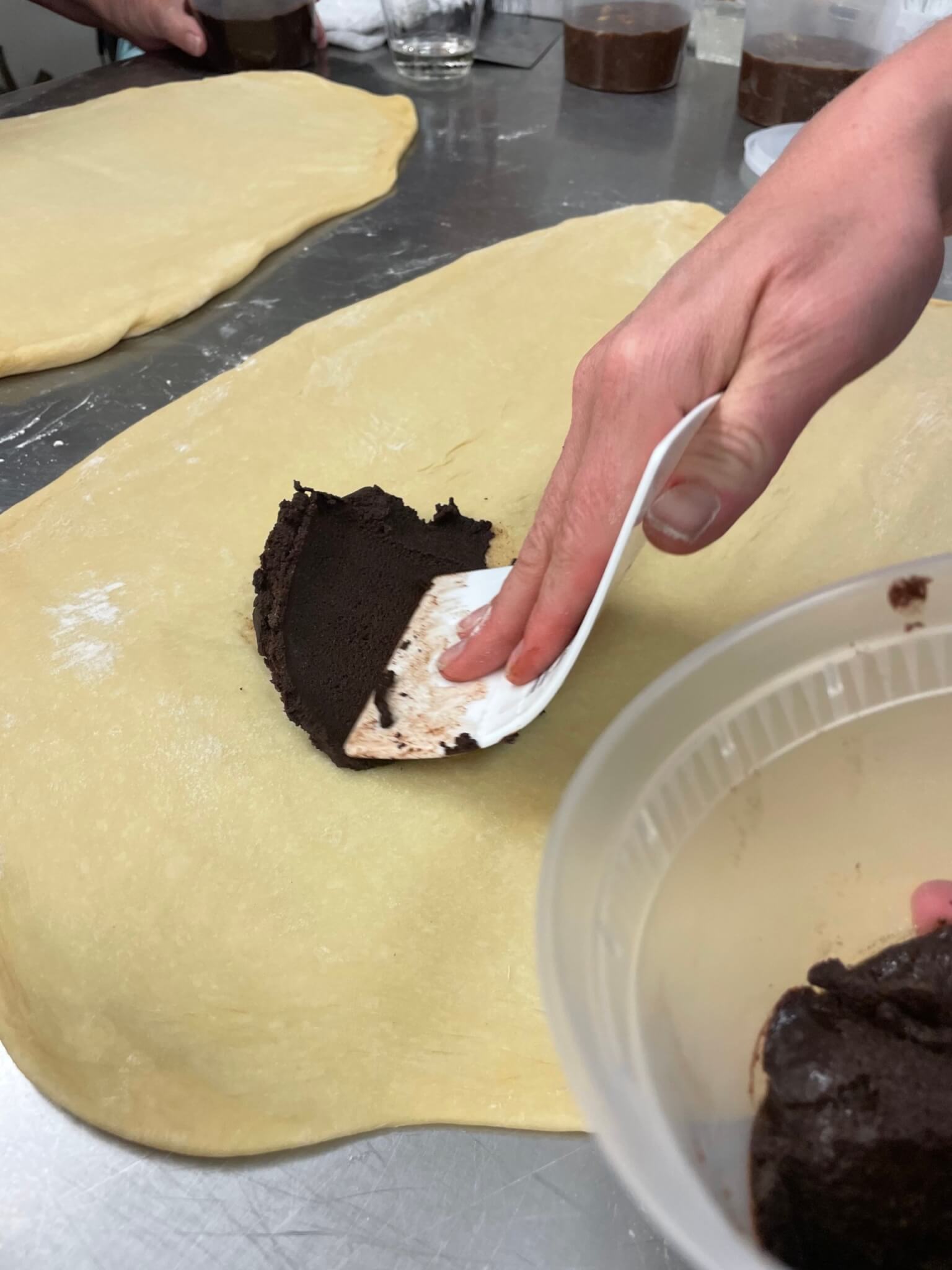 If, as she also says, “the filling is the star (of a babka),” the dough is certainly the main stage for the performance.
If, as she also says, “the filling is the star (of a babka),” the dough is certainly the main stage for the performance.
For all intents and purposes, it’s what baker’s nowadays call a “brioche” dough; that is, a basic flour dough enriched with eggs, sugar and much butter. In the case of Hagemeier’s babka, “much, much butter.”
About the dough and its making, Hagemeier has a great deal to say, especially about the development of its all-important gluten backbone.
For a babka to be a good, well-made babka, she notes, “the dough must be glutenized a lot. Because this is an enriched dough, not a plain flour dough where gluten development occurs quickly, this dough must be worked a lot.”
“If you think it’s been worked too much,” she adds, “it isn’t. You cannot overwork this dough.”
Why the importance of such gluten development? Because a babka is
nothing if not a relatively thinly stretched envelope for its deliciousnesses such as schmears, savory or other sweet fillings, cheeses, lekvars and the like.
Hence, the envelope must be thin but it also must be strong. During the babka-baking class, she holds a sheet of smooth, rolled-out dough up to the light. “See,” she says, “no rips or weak spots.”
Hagemeier’s motto is “Baking is my yoga” and her very Zen-like approach to baking, in truth, helps make for a better-tasting babka.
“If the dough fights you,” she suggests, “just let it rest.” It’s as if to say that when you come back to the dough, the student will be ready.
“When you roll it out,” she says, “just push it where you want it to be.” She calls that “strategic rolling.” At her work counter and beneath her hands, it appears more like good parenting.
Baking can be a process wracked with tension, with its precision in measurement and what may feel like split-second timing. Hagemeier’s very tactile, sensual, even go-with-the-flow approach to baking is its opposite, a delicious comfort.
Just like a babka.
BABKA RECIPE:
By Luisa Hagemeier. All measurements in grams are by weight. Yields two 9-inch loaves.
Ingredients
For dough:
- 120 milliliters (1/2 cup) whole milk
- 7 grams (1 packet) active dry yeast
- 70 grams granulated sugar
- 550 grams all-purpose or bread flour
- 1 and 1/2 teaspoons salt
- 1 teaspoon vanilla extract
- 4 large eggs
- 140 grams butter, soft
For crumb topping:
- 225 grams all-purpose flour
- 200 grams granulated sugar
- 100 grams melted butter
- Pinch salt
For the syrup:
- 100 grams water
- 100 grams granulated sugar
For chocolate schmear:
- 220 grams granulated or brown sugar
- 150 grams unsalted butter, melted
- 150 grams bittersweet chocolate
- 50 grams unsweetened cocoa powder
- 2 teaspoons vanilla extract
- Pinch of salt
For cinnamon schmear:
- 200 grams light brown sugar
- 100 grams unsalted butter, softened
- 15 grams all-purpose flour
- 8 grams ground cinnamon
- Pinch of salt
Directions
Make the dough. Warm the milk to lukewarm, put in bowl or stand mixer and add yeast. Add flour, then eggs, sugar, salt and vanilla. Place bowl on mixer fitted with dough hook and mix on low speed until ingredients are incorporated. Turn mixer up to medium speed and mix for about 5 minutes. You are ready to move on to the next step when the dough resists when you pull at it. It will feel like the tension of a rubber band.
With mixer on low speed, add butter one tablespoon at a time, waiting for butter to incorporate before adding the next tablespoon. This can take up to 10 minutes.
Once all of the butter has been incorporated, turn mixer up to medium-high speed and mix for 10 minutes, or until dough is a cohesive ball around the hook and the bowl is clean.
Place dough in a greased bowl, cover with plastic wrap and allow to rise for an hour. Press dough down and stretch and fold. Re-cover bowl and place in refrigerator overnight or for at least 4 hours.
Make the fillings. For the chocolate filling, place chocolate in melted butter. Stir until thoroughly melted and combined. Add sugar, cocoa powder, vanilla extract and salt and stir until thoroughly combined. Cool on counter. For cinnamon filling, place all ingredients in a food processor and process to a smooth paste. Store on counter.
Shape the babka. Spray two 9×5-inch loaf pans and line with a parchment paper sling. Flour work surface very lightly and divide dough in half. Return one half to refrigerator while shaping first babka. Press first half of dough into a rectangle and then roll it out to about 1/4-inch thickness, approximately 12×16 inches. During rolling process, move dough frequently and re-flour work surface, if necessary, to assure dough is not sticking.
Once dough is fully rolled out, spread fillings over the dough, leaving a small border at the top so that roll can be pinched together. Start rolling dough into the form of a log from the bottom, rolling as tightly as possible. Seal the open flap.
Cut log down the middle the long way (I use a bench scraper to cut it). Keeping the cut side up, make an “X” with the two strands and then twist the strands around each other both above and below the center of the “X.” This is the best way to make the twist even from top to bottom. If you start twisting at the top and work down, you will end up with a twist that is skinnier at the bottom. Place in loaf pan. repeat with second half of dough.
Place pans in a warm place and allow to rise for 30 minutes. Preheat oven to 350 degrees.
Make crumb topping and syrup. Toss sugar, flour and salt together and drizzle in the melted butter. Mix with your fingers to form nice clumps of streusel. For syrup, place sugar and water in pan and heat until sugar is melted.
Sprinkle crumb topping on proofed loaves and place in oven. Bake for 40-60 minutes, turning halfway. Start on the lower end of the time range and add time as necessary. If you make smaller or larger babkas, you will need to adjust bake time. Test babka with skewer.
As soon as the babkas come out of the oven, poke with a skewer all over and pour syrup over top. Cool in pans. Wrap tightly in plastic wrap to store.
Suggestions:
There are as many variations on babka as there are fillings that you can imagine. Try it with apricot or prune lekvar, cheesecake filling, frangipane (almond filling), jam or really anything you like. You even can try savory options such as sautéed onions and Gruyère cheese, or feta and spinach. (For savory babkas, omit the syrup pour-over.) It is also fun to experiment with different flavored syrups, which you can make by adding to the basic syrup recipe. Some possibilities are extracts (orange, almond, lemon, etc.), spices (cinnamon, cardamom, clove, etc.) or alcohol such as rum.
Babka-baking tips from Luisa Hagemeier:
- Babka takes planning: You must make the dough at least a day ahead.
- The best yeast to use is fresh yeast, although instant or rapid yeasts work too.
- The mixer may get hot. That’s OK, just let it rest for a minute.
- Do not sprinkle too much flour on the work surface—only a small amount—because this dough is so strong.
- Spraying the pan isn’t 100 percent necessary because there is so much butter in babka dough.
- The dough is good, but the filling is the star, so you want a high filling-to-dough ratio.
- Spread the schmears with an offset spatula if you have one. If not, Hagemeier uses an OXO Good Grips-brand scraper/chopper.
- Lay cinnamon schmear on top of chocolate schmear.
- Always keep the strands filling-side-up when weaving them or placing them into the loaf pan. This way, the filling is less prone to leak.
- And always bake babka on an ovenproof tray covered in a sheet of parchment paper. Babkas sometimes overflow and that baked-on sugar can get very sticky.
- Babka is done when the dough bakes to 190 degrees. But don’t use a thermometer to check it anyway. The filling can easily get hotter than 190 and that would throw off a reading. Instead, use a skewer to test, as you would for any other baked good.

